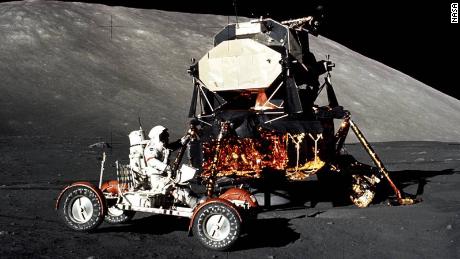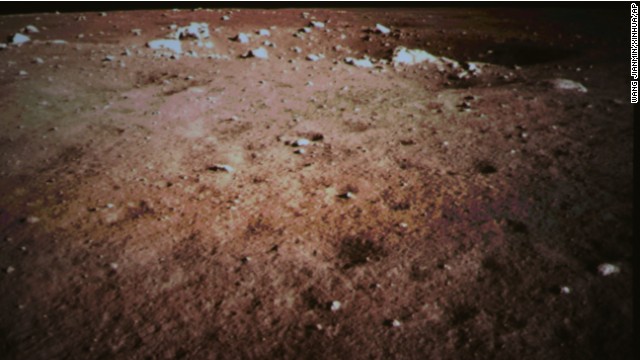Story highlights
- Lost Apollo mission tapes were recovered to solve a lunar mystery
- Astronauts effectively helped heat up the moon at experiment sites
(CNN)NASA's Apollo missions in the 1960s and '70s served not only to land Americans on the lunar surface but to answer key questions about the moon that could be answered only by going there.
As often happens, those answers sometimes stirred up more questions -- or, as in this case, an abiding mystery.
During the Apollo 15 and 17 missions in 1971 and 1972, astronauts installed probes at two sites to measure the moon's temperature below the surface. The Apollo program ended in 1972, but raw data on the temperature of the moon's surface, as well as a few meters below it, was transmitted from the probes and recorded on magnetic tapes at NASA's Johnson Space Center in Houston from 1971 to 1977.
In 1974, the subsurface of the moon unexpectedly rose in temperature by 1.8 degrees to 3.6 degrees Fahrenheit near the probes. The possible reasons for this change were debated by planetary scientists for decades. The mystery was only deepened by lost mission tapes that would account for temperature data from 1975 to 1977.
For the past eight years, a team of researchers has dedicated themselves to recovering the lost data and solving the mystery. Now, their findings and recovered Apollo mission data that weren't previously well-publicized can see the light of day. The study was published this month in the American Geophysical Union's Journal of Geophysical Research: Planets.
A decadeslong mystery
The objective of the Apollo Heat Flow Experiment was to measure the rate at which the moon is losing thermal energy, Walter Kiefer, study author and senior staff scientist at the Lunar and Planetary Institute in Houston, wrote in an email.
"This is important because it controls the rate of internal geologic activity on the Moon," Kiefer said. "For context, the thermal energy coming out of Earth controls the rate at which Earth's geologic plates move, the development of mountain ranges, earthquake activity and volcanic eruptions."
Once the raw temperature data were recorded on tapes, they were given to mission scientists for analysis and archiving. But the tapes from 1975 to 1977 were never archived.
"The mystery persisted for so long because no one was working on this problem," Kiefer said. "NASA began an effort at recovering old mission data [Apollo and other spacecraft] in 2010, when our team began working on this problem."
A separate set of archival tapes including data from April through June 1975 was found at the Washington National Records Center. Weekly logs that included temperature readings from the probes, comprising 1973 through 1977, were found at the Lunar and Planetary Institute in Houston to fill in the gaps.
But the data had to be recovered from the old tapes in order to be usable and then analyzed. This process took years, but the data recovery efforts were successful.
At the time of the initial experiment, mission scientists weren't expecting to see this warming at the site of the probes. The unexpected data left them feeling uncertain.
"By adding the new data into the study, we now understand the data trends and can reliably interpret the experiment results," Kiefer said.
Walking on the moon
Once all of the puzzle pieces of the data were put back together, the researchers were able to analyze the previously suggested scenarios for what warmed the moon.
Based on the data set, warming happened at the moon's surface and traveled to the subsurface. The researchers were also able to look at recently acquired images from the Lunar Reconnaissance Orbiter Camera over the two landing sites.
The only scenario that fits this type of warming is that the astronauts caused it.
While they were driving a rover over the surface, walking and installing the probes, they disturbed the moon's surface, which is covered in regolith, a layer of dust and debris. Images from the camera show that those paths were darker, which lowered their albedo, or ability to reflect the sun's light into space.
"This was very localized in the regions where the astronauts worked extensively," Kiefer said. "In these areas, the astronaut bootprints darkened the lunar regolith [or soil] slightly, causing the regolith to absorb more sunlight and heat up. This was a region 50 to 100 meters across in the experiment deployment zone and of similar or smaller sizes at the sample collection stops. Outside of these zones, the astronauts had little or no effect on the subsurface temperatures."
This is valuable information in the event that similar experiments are carried out in the future. Suggestions in the study include equipping a lunar lander with additional instruments to monitor the regolith as it lands or robotically deploying a probe to the right depth.
"In the process of installing the instruments you may actually end up disturbing the surface thermal environment of the place where you want to make some measurements," said Seiichi Nagihara, lead study author and a planetary scientist at Texas Tech University, in a statement. "That kind of consideration certainly goes in to the designing of the next generation of instruments that will be someday deployed on the Moon."











